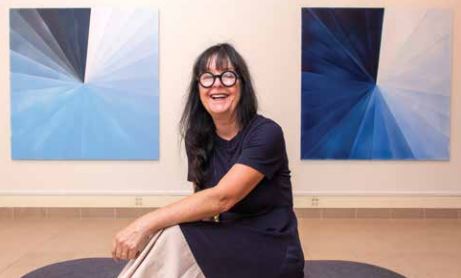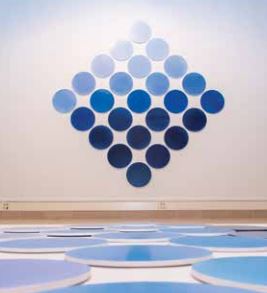
Saskatoon artist Marie Lannoo is known across Canada and internationally for the innovative, visually stimulating artwork she creates by employing conceptual research and scientific methods of experimentation.
In a survey exhibition of her latest work, entitled the architecture of colour, Lannoo explores colour and light through paintings and sculptural installations that are currently on display at the College Art Galleries on the University of Saskatchewan (USask) campus until Dec. 21.
Influenced by abstraction and modernism, Lannoo’s work challenges how viewers see colour in their day-to-day lives, while also highlighting the complexity and illusion, as well as the magic and beauty, that can be found in colour experiences. “I am a painter and I have been focused, in my studio, on two particular areas —light and colour, colour and light — in my work. This is a survey of research that I’ve been doing for the last five years in the studio, or there-abouts,” said Lannoo, a USask alumna who earned her bachelor’s degree in French in 1977.

display in the College Art Galleries until Dec. 21.
(Photo by Chris Putnam)
“The overarching desire on my part for the exhibition is that it provides my audience, or my viewers, with experiences of colour that they may be unfamiliar with or that may be new to them, or that they may simply need reminding of,” she said. “I set the show up to be somewhat interactive. There are a few pieces that you can actually touch and move around, and others that you actually have to walk around to get the full effect of the piece. I really was interested in having my viewer participate — interact — with the abstraction. Abstraction can be distancing, I would say, and I was very interested in engaging my audience with a sort of up-close-and-personal look at colour and light.”
Leah Taylor, who curated the exhibition, visited Lannoo’s studio several times during the past five years to see her latest body of work in development. Taylor said the work demonstrates that Lannoo is “a great painter who continually pushes the formal qualities of painting to the edges — and right off the canvas.”
The timing of the Lannoo show felt right for the College Art Galleries, “given the interdisciplinary conceptual considerations pertaining to light, the science of colour and the prairie sky,” said Taylor. It was also the right time in Lannoo’s artistic career to have a survey-scale exhibition, she added. “In a way, this exhibition is bringing some of her realized artistic research on light and colour back to USask, given that she had worked with a group of scientists at the Canadian Light Source synchrotron in 2010-11,”
Taylor said.
Much of Lannoo’s latest work is inspired by her personal experiences and her observations of the natural world around her. The artwork entitled Blue Eyes Blue 1,2,3,4 (from Iceland), for example, was created following Lannoo’s trip to the Blue Lagoon Spa outside Reykjavik, Iceland, where light interacts with mica flakes in geothermal seawater to emit what she calls “an otherworldly blue.” “What’s inside of it is silica sand, and it is light interacting with silica sand — the silica sand particles — and emitting this gorgeous blue,” Lannoo said. “And so I came back to Canada and said, ‘I’ve got to find a way to duplicate or to recreate an experience of this blue.’ ”
Phosphorescence is defined as luminescence that is caused by the absorption of radiations — such as light or electrons — and that continues after the radiations have stopped. With Blue Eyes Blue 1,2,3, Lannoo used a paste of phosphorescent blue powder and acrylic applied to canvas. Once charged by light, each piece radiates the colour blue — similar to that of the water in Iceland.
With her artwork Skin and Bones, Red, Yellow, Blue, wavelengths of the visible light spectrum were etched into the surface of an acrylic disc, painted with acrylic. The wavelengths illuminate their colour via transparent gels on the back of the panel and, when all wavelengths are at the same intensity, white light is produced in the centre of the panel. “There’s colour activity happening both on the surface and on the back of that surface as well — on the back of that painting,” Lannoo said.
One theme that stands out in Lannoo’s show is her interest in the colour of the sky. Saskatchewan residents are “sky people,” she said, so blue is the predominant colour in our surroundings. The work that connects Lannoo’s new exhibition directly to this sense of place is the series Blue Sky over Saskatoon and Summer, Winter, Fall Blue. In that work, Lannoo documented the colour of the blue sky, painting it according to a regimented timeline beginning at 7 a.m. and ending at 10 p.m. — reflexive of the research by Swiss physicist Horace Bénédict de Saussure and the cyanometer, the 230-year-old tool he created for measuring the blueness of the sky.

painting it according to a regimented timeline beginning at 7 a.m. and
ending at 10 p.m. (Photo by Chris Putnam)
Ultimately Lannoo — who studied art at USask with highly respected professors such as Eli Bornstein, Mina Forsyth, Otto Rogers and Stan Day — considers herself to be a painter, and is quick to note that she is not a scientist. Still, she has worked with scientists at the Canadian Light Source synchrotron, and it was these scientific partnerships that made possible her acclaimed 2010 Mendel Art Gallery exhibition Through and Through and Through.
Lannoo said one of the things she is interested in is exploring “tiny space” and finding out what happens to colour there. It’s in that tiny space, she said, that wavelengths are travelling through the ether. Those wavelengths are then processed by our eyes and brains, allowing us to see colour. “That’s really kind of the heart of the show,” she said. “The soul of the show is experiential. Yes, I have researched colour and found out a lot of really, really interesting things — and I will continue to do so — but I am interested in the body’s reception of these particular structures and how it reacts and interacts with these things to navigate through the world. I’m interested in experience of colour.”
Taylor said she admires Lannoo’s constant curiosity and consistent studio practice, as well as Lannoo’s support of the Saskatchewan arts community — particularly young, emerging artists and those who have worked with her at 330g, her independent artist-run space in Saskatoon’s Riversdale neighbourhood. Also in Riversdale, a commissioned installation by Lannoo entitled Stretched and Framed — featuring a set of continuous bands of the colours of the spectrum moving into and out of each other — has been on view at Storefront, located at 325 21st St. West, this fall.
Work by Lannoo is also included in Remai Modern’s exhibition entitled Recent Acquisitions: Part Two, which features artists exploring the formal and perceptual qualities of light and colour, including Robert Youds and fellow Saskatchewan artist Jonathan Forrest. That show will remain on view until Jan. 4, 2020.
Taylor describes Lannoo as “an insatiable reader” who understands where she is positioning herself within the framework of international contemporary art, while acknowledging the influential history of abstraction. Lannoo recently created a new sculpture for the Saskatchewan Arts Awards, entitled North, South, West, East – Nothing, Something, Wavelengths, Everything. Each award represents one colour of the spectrum and has one colour gradation. “She has never stopped exploring her medium and is constantly re-evaluating and reinventing where she can take her research and, therefore, her practice,” said Taylor.
– Shannon Boklaschuk
